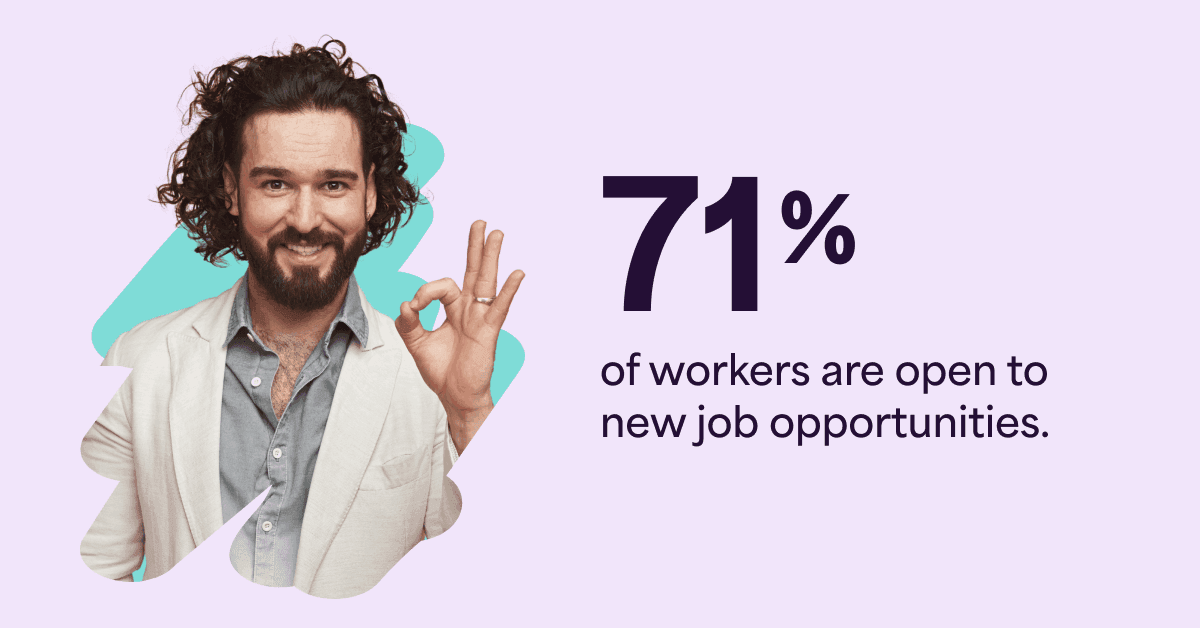Welcome to the ultimate guide to recruiting passive talent! This guide is crafted for recruiters, talent acquisition pros, and HR generalists eager to elevate their talent-sourcing strategies.
Passive recruiting is, ironically, the most active form of recruitment, and it's an essential part of any top-performing recruitment strategy. By actively reaching out to candidates in addition to accepting applications and referrals, you ensure you have the best possible talent pool to draw from and start building relationships with. Simply waiting around for candidates to come to you severely limits your options.
In a world where the demands on recruiters are higher than ever, there's no time to start optimizing your passive recruiting efforts like the present. So, don't be passive in your recruiting; instead, embrace passive recruiting.
Let's dive in!
What are Passive Candidates? 🔍
Passive candidates are generally defined as individuals that are:
- Currently employed and performing well in their roles
- Not actively job hunting or browsing job boards
- Potentially open to new opportunities if approached with the right offer
70% of the global workforce is made up of passive talent who aren’t actively job searching for a new job. This statistic highlights the immense potential that lies within the passive candidate pool.

What is Passive Recruiting? 🧩
Passive recruiting is a strategic talent acquisition approach that focuses on identifying and attracting potential candidates who are not actively seeking new job opportunities but may be open to offers. This allows organizations to tap into a vast pool of skilled professionals they wouldn’t through job listings alone.
The Benefits of Passive Recruiting 🏆
Passive sourcing offers numerous advantages for organizations looking to attract top talent. By connecting with these highly skilled and experienced professionals, you'll have access to a wealth of untapped potential.
Let's explore the key benefits of incorporating passive sourcing into your recruitment strategies.
Higher Quality of Hire
Passive candidates are often among the most qualified and experienced professionals in their respective fields. Since they are typically already employed and have proven track records, they are less likely to require extensive skill development or training upon being hired.
Research from LinkedIn shows passive talent is 17% less likely to need skill development compared to active job seekers. Furthermore, passive candidates tend to be highly motivated and driven, with a 120% higher likelihood of wanting to make a significant impact on your business.

Improved Diversity
Passive sourcing allows you to reach a more diverse pool of candidates, including individuals from underrepresented groups who may not be as likely to actively apply for roles. To highlight this further, research conducted by LinkedIn found that women are 16% less likely than men to apply to a job after viewing it, apply to 20% fewer jobs, and are 26% less likely to ask for a referral.
By proactively sourcing passive candidates, you can increase the diversity of your applicant pool and potentially identify exceptional talent that may have been overlooked through traditional recruitment methods.
Women are 16% less likely than men to apply to a job after viewing it, apply to 20% fewer jobs, and are 26% less likely to ask for a referral.
Reduced Time to Hire
Building a strong pipeline of passive candidates can significantly reduce the time it takes to fill open positions. By continuously sourcing and engaging with potential candidates, you create a pool of warm prospects who are already familiar with your organization and may be more receptive to new opportunities when they arise.
Still need some convincing? Gem, a popular recruiting technology company, found that their customers hired outbound candidates at a rate 5x higher than inbound applicants. That’s a great reason to start being more proactive.
Passive Recruiting Tools and Platforms 🛠️
Utilizing the right tools and platforms is crucial for enhancing your passive sourcing efforts. These resources can help you find, engage, and nurture potential candidates more effectively.
Professional Networking Platforms
Platforms like LinkedIn, GitHub, and Behance, to name just a few, are invaluable for finding and connecting with professionals across various industries and fields. These types of platforms allow you to search for candidates based on specific skills, experience, and other criteria, making it easier to identify and reach out to potential fits.
Automation & AI Tools
Streamlining and automating the sourcing process can save time and increase efficiency. Tools like Fetcher, Gem, and Beamery are designed to help recruiters automate tasks such as candidate sourcing, outreach, and nurturing — and they’re catching on.
In their most recent Employ Recruiter Nation Report, Jobvite found that 58% of recruiters and HR decision makers are already using AI to augment their current recruitment technology tech stack. Automation and AI-enhanced tools can help you scale your efforts, reach a wider pool of candidates, and stay organized throughout the process.

University Recruitment Platforms
If you're looking to hire entry-level talent or recent graduates, university recruitment platforms like Handshake can be invaluable. These platforms connect employers with students and alumni from various universities, making it easier to find and engage with potential candidates.
If you prefer to make a more direct connection, on-campus programs are growing in popularity following the COVID-19 pandemic and are another great way to engage with eager young talent.
Candidate Relationship Management (CRM) Tools
Recruitment tools with CRM features, such as Fetcher, Ashby, and Gem, can help you manage and nurture your passive candidate pipeline more effectively. These tools allow you to create and save talent pools, message candidates directly, track interactions, and stay organized throughout the entire sourcing and hiring process.
Additionally, many CRM tools offer robust analytics and reporting features, which can help you measure the effectiveness of your passive sourcing efforts and more easily identify areas for improvement.
Employer Branding Platforms
Building a strong employer brand is essential for attracting and engaging passive candidates. Platforms like LinkedIn Talent Hub, Comparably, and Glassdoor can help you showcase your company culture, values, and employee experiences to potential candidates.
Similarly, investing in platforms such as Frontify and Bynder to host and maintain brand guidelines, and using tools like Canva to easily create on-brand materials, can be great ways to ensure that you are consistently hitting the mark.
By creating and sharing a compelling employer brand, you can increase your visibility and appeal to passive candidates who may not have considered, or ever even noticed your organization otherwise.
Looking to streamline your processes, engage candidates effectively, and take your recruiting strategies to new heights? Schedule a demo with Fetcher today!
Passive Recruiting Techniques and Strategies 🎯
Implementing the right techniques and strategies is key to finding great passive candidates. With these approaches, you can make your search easier, connect with candidates more effectively, and build a strong talent pipeline.
Data Mining and Boolean Searches
Data mining and boolean searches can be powerful tools for identifying and targeting the most relevant candidates as quickly as possible. Boolean searches enable you to refine your search results by specific criteria, such as skills, qualifications, and experience, leading to a highly targeted and streamlined process.
Better yet, some recruiting tools can simplify the process by handling the complexity of writing boolean searches through user-friendly interfaces, making it easier to search through extensive databases regardless of your technical acumen.
Broadening Your Searches
It's important to keep in mind that relying solely on databases and LinkedIn profiles may not always lead to finding the best candidates. Some excellent candidates may not have complete profiles, and others with impressive public skill sets might not be interested. So, it's a good idea to keep an open mind and consider reaching out to a wider range of candidates, even if they don't meet every requirement on paper.
Automation and messaging tools can help alleviate much of the manual workload that comes with increased outreach, and you’ll have a much more expansive pool of interested candidates to engage with. By expanding your searches to include talent you may have otherwise overlooked, you can spend more time talking with great talent and less time waiting for replies that may never materialize.
Keep an open mind and consider reaching out to a wider range of candidates, even if they don't meet every requirement on paper.
Building Talent Communities
Creating and nurturing talent communities is an effective way to build a pool of prospective candidates and establish long-term relationships. By regularly sharing company news, available roles, and other relevant information with these communities, you can keep your organization top-of-mind for potential candidates and foster a sense of engagement.
Personalize Your Outreach
Crafting personalized and compelling messaging is crucial for effectively connecting with passive candidates. By tailoring your outreach to individual candidates' backgrounds, interests, and career goals, you can increase the likelihood of capturing their attention and fostering a positive response. The more you can make a candidate feel special, the more difficult it is for them to ignore your pitch.
If you need help finding the right words, popular AI tools like ChatGPT or Claude can assist in creating different messages and subject line variations to test and optimize for better response rates.
Long-Term Nurture Campaigns
Developing long-term nurture campaigns is an effective way to build relationships with passive candidates and keep them engaged with your organization over time. These campaigns involve providing valuable content, such as industry insights, career development resources, webinars, and company updates, to potential candidates.
By consistently delivering relevant and valuable information, you can position your organization as a thought leader and increase the likelihood of candidates considering your company when they are ready for a career change.
Common Mistakes to Avoid in Passive Recruiting ⚠️
While passive sourcing is an incredibly effective strategy for attracting top talent, it's essential to avoid common pitfalls that can undermine your efforts. By dodging these mistakes, you can enhance the effectiveness of your sourcing campaigns and increase your chances of engaging with higher-quality candidates.
Spelling Errors and Jargon
Ensuring clear and professional communication is crucial when reaching out to passive candidates. Poorly written messages with spelling errors or excessive use of jargon and buzzwords can negatively impact your credibility and turn off potential candidates.
To highlight this further, a study by Linguix found that emails with spelling and grammar errors are 26.3% less likely to receive a response, with 53.4% of respondents indicating they would not do business with someone who sends emails with poor spelling and grammar. Take the time to proofread your messages and use straightforward language to convey your message effectively, it’s worth it.

Boring Subject Lines
Inboxes are flooded with messages every hour - you’ve probably received a dozen since you started reading this guide. Crafting attention-grabbing and relevant subject lines is crucial for ensuring that your messages are opened and read by potential candidates. Consider using compelling language or posing a question that piques the recipient's curiosity and encourages them to engage with your message. Very few people want to work for a boring company, so it’s best to set the right tone immediately with them.
Generic Email Addresses
Using a personal and credible email address for outreach can make a significant difference in candidate engagement, even if the message is automated. Generic email addresses like info@company.com or noreply@company.com can come across as impersonal and detract from the authenticity of your outreach efforts. Recruiting is all about forging personal connections, so why not kick things off with a personal touch?
Not Following Up
Let’s face it - people are busy and inboxes are incredibly messy. Consistent follow-up is essential for keeping passive candidates engaged and interested in your opportunities. Develop a follow-up strategy that involves multiple touchpoints and personalized messaging to ensure that your outreach efforts are not overlooked or forgotten by potential candidates. Being persistent is often the only way to cut through the noise, so keep at it.
Neglecting References
While passive candidates may present impressive resumes and credentials, it's essential to verify their claims by checking references. While it may seem like a routine formality, respondents to a recent Robert Half survey reported removing a staggering 34% of job candidates from consideration for a position after a reference check.
Reference checks are a quick and easy way to ensure peace of mind. On the flip side, neglecting to check references can lead to costly hiring mistakes and damage your organization's reputation. A little due diligence can go a long way.

Relying on a Single Source
Diversifying your sourcing channels is crucial for accessing a wider pool of potential candidates. Explore multiple platforms, networks, and sourcing strategies to increase your chances of finding the right candidates for your open positions. Different roles, seniority levels, and geographic locations can all have a big influence on where your ideal candidates frequent and can be reached. So, don’t be afraid to broaden your searches.
The Importance of Relationship Building 🤝
Building and nurturing strong relationships is a critical component of successful passive sourcing strategies. By fostering positive connections both internally and externally, you can streamline processes, enhance candidate experiences, and ultimately attract top talent more effectively.
Internally
Effective collaboration with hiring managers is essential for aligning on role requirements, expectations, and candidate criteria. Conduct thorough kickoff or intake meetings to ensure a shared understanding of the position's needs and the desired candidate profile. At the end of the day, recruiters and Hiring Managers share the same goal: they want to find the best individuals for their open roles.
With Candidates
According to Indeed’s 2024 Workforce Insights Report, 71% of workers are open to new job opportunities, even if they aren't currently looking. Building strong relationships and a rapport with these candidates, even when they aren't interested in your available opportunities, can pay real dividends in the long run.
By nurturing these connections through tactics such as personalized outreach, sharing relevant content, corporate newsletters, and providing a positive candidate experience, you increase the likelihood that these individuals will consider your organization and reach out when they're ready for a change. You really never know who might be your next great hire, so try and leave a good impression with everyone you cross paths with.
Being on good terms with silver medalists can be incredibly advantageous as well. It's a good idea to include them in nurture sequences and talent communities, as they have previously shown interest in your company. They are also likely to have speedier time-to-hires than newer applicants. You never know if circumstances will change or if other roles will become available that are better suited for them in the future, so it's important to nurture these relationships.

Diversity, Equity, and Inclusion (DE&I) Considerations
Prioritizing diversity, equity, and inclusion throughout your recruitment process is not only ethical but also highly strategic. Different groups may face unique challenges and barriers, so it's essential to understand and address these factors. Tailor your approach to ensure an inclusive and supportive environment for all candidates.
Prioritizing diversity is an important consideration for candidates, too. A study by Glassdoor found that 67% of job seekers consider diversity an important factor when evaluating potential employers, underscoring the importance of demonstrating a real commitment to DE&I.

Measuring Effectiveness 📊
Tracking and analyzing key metrics is crucial for evaluating the success of your passive sourcing strategies and identifying areas for continuous improvement. By measuring the right indicators, you can gain valuable insights into the effectiveness of your efforts and make data-driven decisions to optimize your approach moving forward.
Source of Hire
Identifying which sourcing channels are most effective in yielding successful hires can help you prioritize your efforts and allocate resources accordingly. This can often vary wildly by role, seniority, and job locations, so tracking where your outreach is successful is critical. By understanding the relative performance of each channel, you can focus on the most productive avenues and adjust your strategies as needed.
Conversion Rates
Monitoring conversion rates throughout the recruitment funnel can provide valuable insights into candidate drop-off points and areas for improvement. By tracking conversion rates at each stage, you can identify bottlenecks and optimize your processes to ensure a smooth candidate experience and better retention.
Offer Acceptance Rate
While finding great candidates is great, welcoming them to your organization as a new hire is the ultimate goal. With this in mind, your offer acceptance rate is a key indicator of how compelling your job offers and your organization are perceived by candidates. By monitoring this metric, you can assess the competitiveness of your offers and make adjustments as needed to ensure you aren’t losing out on potential talent.
Time and Cost per Hire
Evaluating the efficiency and cost-effectiveness of your hiring process is essential for optimizing your often limited resources. By tracking these metrics, you can identify opportunities to streamline your processes and reduce costs associated with sourcing and hiring.
It's important to note that the wrong hiring decision can have significant financial consequences. According to industry estimates, bad hires can cost up to $240,000 in expenses related to hiring, compensation and retention. By measuring the effectiveness of your passive sourcing strategies and making data-driven decisions, you can mitigate these risks and ensure a higher return on investment in your recruitment efforts.
Bad hires can cost up to $240,000 in expenses related to hiring, compensation and retention.
In Conclusion 🏁
Passive sourcing is a powerful strategy for finding top talent, and an essential part of any top-performing recruiting strategy. By leveraging the right tools, techniques, and methods, you can build a strong and diverse talent pipeline that meets your organization's needs. Start implementing these data-driven tips today and watch your hiring process transform!




